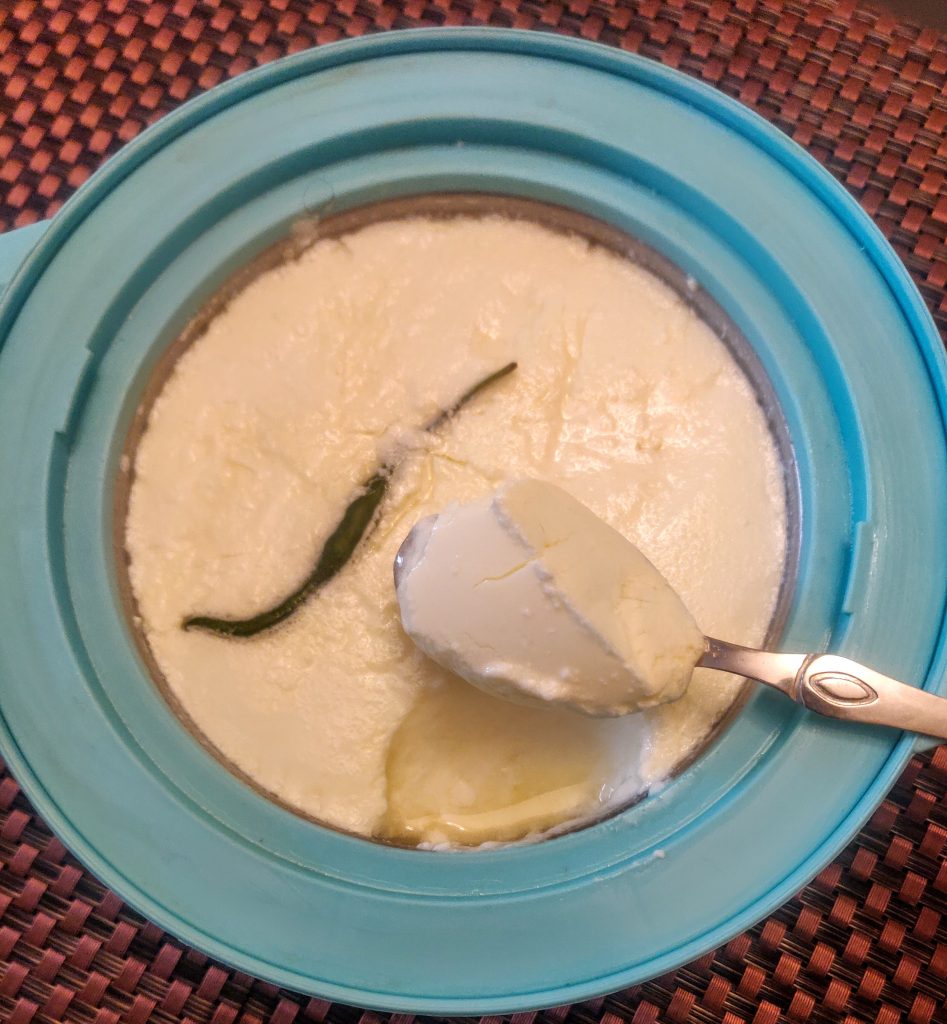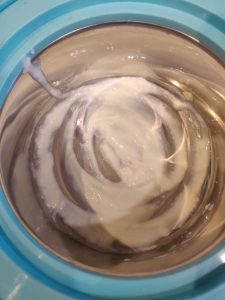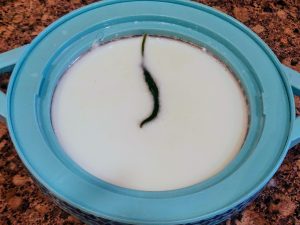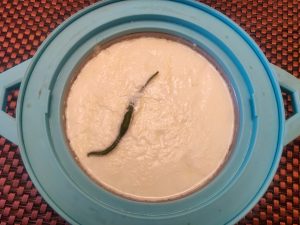Let's see How To Make Curd At Home Perfectly In Winters too or say how to set curd at home by following this simple trick and some easy yet important steps.
Believe me, this curd was set in even less than 3 hours when Delhi was freezing at 12 degrees in the daytime. And it sets like this every time. All thanks to certain tips that I follow religiously, especially in winters.
So, if you are among those who go for store-bought curd in winters or face difficulty in making curd, then go through this post once and your problem will be solved forever!

Curd Set in 3 hours at 12 degrees C
When something gives you the same results repetitively then it is not ''By Chance''. The result may be good or bad but It surely does have some reasoning behind it, and you either stick to it or change it.
In my case, it's the perfect curd every time whether its summers or Delhi winters. Even during winters, I have to check it after 2 hours only, this is because if left for long, then I get curd set in a pool of whey (water)
Must Read: Difference Between Curd And Yogurt
We all love Dahi and use it in varied ways.
We have it in breakfast as flavoured yogurt (Yogurt Muesli) or lassi (Jowar Buttermilk), in our daily meals in the form of plain curd or raita (Bathua Raita), then it is used in many chats (Palak Patta Chat) and snacks (Air-Fried Idli Chat) and also in preparation of many veggies.
Not to forget, everyone's favourite Dahi Vadas. If you are calorie conscious, then do try this Oil-free No-cook Dahi Vadas!
Also used as a beauty product like applying to face or hair. It is a versatile item.
Related Recipes
- How to make Hung Curd
- Frozen Strawberry Yogurt
- Curd Bread Toast
- Mango Yogurt
- Steamed Yogurt/Bhapa Doi
Step By Step Photos Showing How To Make Curd At Home
- Boil milk and wait till it is lukewarm. You may use full-fat milk for better results but I normally use low-fat milk only, commonly known as Toned Milk.
- Take 1 to 2 teaspoons of starter or culture (already set curd) for 500 ml milk in a bowl and smoothen it using a spoon.
- Add lukewarm milk to this smoothened culture and mix nicely with a spoon.
- Now drop green chilli with the stem attached to it. You can even put just the stem of green chilli.
- Don't worry, there will not be any chilli in your yogurt. No taste of it. Also, you can take any normal green chilli for this purpose. What is important is its ''stem''.
- Cover this bowl with a lid or plate and keep it undisturbed in one corner.
- In summers, it will set within 2 to 3 hours whereas in winters it will take longer, up to 4 hours.
- Once set, keep this bowl in the refrigerator
- It's better to set your curd in the night before you say goodnight and you get a perfect curd by the time you say good morning.
- You can also use whey, that is curd water, water left after making hung curd, as the starter.
Why Is It Difficult To Set Curd In Winters?
Making curd in winters at home is undoubtedly difficult. As the temperature drops, difficulty in setting curd increases. Right? But there are ways to tackle that difficulty and make it easy. Let's see how.
It is a common practice in many households to set curd on a daily basis. During summers it is very easy to set curd and it usually sets within 2 to 4 hours depending on the outside temperature. But setting curd in winters is no less than a Herculean's task. As the temperature drops, the curd setting becomes tougher.
Tips For How to Prepare Curd at Home In Winters
So, to sum up, my tips for making curd at home in winters are:
- In winters, use a casserole for setting curd. A casserole is an insulated container that retains the heat. For better results, wash the casserole with hot water before setting curd in it.
- Use slightly more warm milk to make the curd. A little warmer than lukewarm.
- Use more starter than in summers.
- Drop green chilli with the stem attached to the milk.
- Close the casserole and keep it in some dark place. Microwave or Otg is the best place for this purpose. Just switch on the light of these appliances and put the casserole in it. You don't have to run it. Light of the microwave/Otg is enough to give the required warmth needed to set the curd.
- In peak winters, you can even preheat the Otg at the lowest degree in it for 10 minutes and then keep the casserole in it
- n the absence of microwave/OTG, place the vessel in which you are making curd, in a casserole. Add hot water to the casserole and close the lid. The casserole will trap the heat which will eventually provide a warm environment and aid in making the curd.I
Special Tip: Start Making Curd in the morning instead of the evening or late at night. This is because the temperature drops more during the night time as compared during the day
Precaution: If you follow these tips then do not forget to check it after 2 hours otherwise, set curd will release a lot of water
The Difference in Making Curd in Summers and Winters
Though the process of making curd remains the same irrespective of the weather yet there are some points to keep in mind with minor differences.
| During Summers | During Winters | |
| Utensil to be used | Make curd in a regular steel or glass bowl. | Use a casserole for setting curd. |
| Temperature of milk | Milk should be lukewarm | Milk should be warm. |
| Quantity of Starter | 1 teaspoon for half a litre milk | 1 tablespoon for half a litre milk |
| Time to Make Curd | Anytime that suits you. | Start the process preferably in the morning as days are warmer comparatively. |
| Green Chilli | May or may not use green chilli. | Must use it for better and quick results. |
Make Curd In Winters Without Shawl/Blanket
I know some people who stop setting curd in winters and go for store-bought curd. It was a difficult task for me also but have now overcome this problem. A common practice is to wrap the bowl, in which cultured milk is put, in some woolen cloth, like a shawl or blanket. But this is not easy because if the milk spills it may spoil your woolens also.
What To Do If Curd Doesn't Set In Winters
- First of all, leave it for a longer period. maybe 12 to 15 hours at times.
- Even then if it doesn't set, then keep it in a bigger vessel/casserole. Then add hot water to the bigger vessel and cover it with a lid. It will trap the heat which will eventually provide a warm environment and aid in making the curd.
My Experience
Believe me, just yesterday when the temperature was 12 degrees Celsius, I managed to set perfect curd in exactly two hours and 30 minutes following the above-mentioned steps. I checked it a little later, as was not expecting it so soon, but by then the curd had set and hence some water which is seen in the pic.
Lets Connect!
Hope you will surely try out this method during this winter and serve homemade curd to your loved ones. Do not forget to share your feedback. Your feedback fuels my enthusiasm to post more good content.
Let’s connect on Facebook, Pinterest, Instagram (#samirasrecipediary) too.
How Green Chilli Sets The Curd?
For all those inquisitive minds who want to understand how chilli sets the curd, please read the details given underneath...
We all know that curd is formed from ed Lactose and protein casein. When milk is heated to a certain temperature 30 to 40 degrees centigrade and a bacteria lactobacillus is added to it then this bacteria multiplies by eating the sugar lactose and lactose is converted into lactic acid. Now, this lactic acid makes milk proteins curdle. And the liquid milk turns into thick curd. It is because of this lactic acid that the curd tastes sour or tangy.
Normally we get this lactobacillus from a small portion of old curd, called culture or starter in simple language.
But the lactobacillus which produces yoghurt occurs naturally on the surface of vegetables and is responsible for their fermentation (i.e. kimchi, Kosher dills, sauerkraut). In the case of capsicums, the calyx of fruits (such as chilli) are often rich in various lactobacilli. These natural bacteria create a starter for lacto-fermentation of the milk. Since the growth of lactobacillus bacteria slows down in winters, below 18 degrees celsius then Capsaicin from the chilli appears to increase the metabolic rate of the lactobacilli. In general household practice, curdling is known to occur faster in the presence of chilli.
Benefits of Eating Curd
- It boosts immunity, improves digestion, good for teeth and bones.
- Helps in releasing stress and anxiety.
- Good for heart and much more.
- People who are lactose intolerant can easily go for curd.
- There are many children (and adults too) who doesn't like milk at all but like to have curd. Thus by having curd, they need not worry of missing on milk.
- To know more about the benefits of curd, click here.
Testimonials


By Ruchi Goyal
Stay Healthy…Stay Happy
My heartfelt thanks to the following links for the needful insight and information.






Thankyou Samira!!
I was buying curds from outside in this winter season. Tried your tips including the green chilli and the curds set when kept in a casserole with hot water inside a dark kitchen cupboard. I had to heat the water one more time. Set within 5 hours.
So nice to hear that. One more suggestion, keep the milk slightly more warm than you usually do for setting curd and you will not have to heat the water in between. Thanks a lot for sharing your awesome feedback.
It has been more than 15 hours and my yoghurt is not set as it is winter where I live. Is there any way i can salvage it instead of throwing it out. I m guessing my milk was not warm enough when i mixed my starter.
Hi Sangeeta, 15 hours is a really long time. keep this curd bowl in a casserole with hot water in it. Also, drop a green/red chilli with stalk in it. It will set in few hours. Keep updates.
I kept the container in a pre heated oven and then it finally set.
Great!
Super,Simple yet Yummy RECIPES! THANKS!!
My pleasure dear…
U have given us Very good tips to set the curd in winters.thanx a lot
My pleasure…